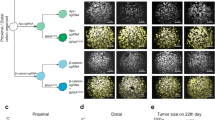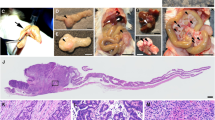Abstract
CDX2 is a Drosophila caudal-related homeobox transcription factor that is important for the establishment and maintenance of intestinal epithelial cells. CDX2 is a marker of colon cancer, with strong staining in up to 90% of colonic adenocarcinomas. CDX2 heterozygous-null mice develop colonic neoplasms, which have suggested that CDX2 is a tumor suppressor. However, CDX2 has not been reported to affect xenograft growth. Furthermore, CDX2 is rarely mutated in colon cancer, which has led to suggestions that it may play only a minor role as a tumor suppressor in colon cancer. To understand the functional contributions of CDX2 to colon cancer, we disrupted CDX2 in LOVO and SW48 human colon cancer cell lines by targeted homologous recombination. Consistent with the literature, disruption of CDX2 enhanced anchorage-dependent cell proliferation. However, homozygous loss of CDX2 led to significant inhibition of anchorage-independent growth in LOVO cells, and cell lethality in SW48 cells. Further analyses revealed that disruption of CDX2 led to anchorage-independent G1 to S growth arrest and anoikis. In vivo xenograft studies confirmed that disruption of CDX2 inhibited LOVO tumor growth. These data demonstrate that CDX2 mediates anchorage-independent growth and survival. Thus, CDX2 has tumorigenic potential in the human colon cancer cell lines LOVO and SW48.
This is a preview of subscription content, access via your institution
Access options
Subscribe to this journal
Receive 50 print issues and online access
$259.00 per year
only $5.18 per issue
Buy this article
- Purchase on Springer Link
- Instant access to full article PDF
Prices may be subject to local taxes which are calculated during checkout




Similar content being viewed by others
References
Abate-Shen C . (2002). Nat Rev Cancer 2: 777–785.
Aoki K, Tamai Y, Horiike S, Oshima M, Taketo MM . (2003). Nat Genet 35: 323–330.
Bai YQ, Miyake S, Iwai T, Yuasa Y . (2003). Oncogene 22: 7942–7949.
Beck F . (2002). Gut 51: 450–454.
Bonhomme C, Duluc I, Martin E, Chawengsaksophak K, Chenard MP, Kedinger M et al. (2003). Gut 52: 1465–1471.
Brabletz T, Spaderna S, Kolb J, Hlubek F, Faller G, Bruns CJ et al. (2004). Cancer Res 64: 6973–6977.
Chan TA, Wang Z, Dang LH, Vogelstein B, Kinzler KW . (2002). Proc Natl Acad Sci USA 99: 8265–8270.
Chawengsaksophak K, de Graaff W, Rossant J, Deschamps J, Beck F . (2004). Proc Natl Acad Sci USA 101: 7641–7645.
Chawengsaksophak K, James R, Hammond VE, Kontgen F, Beck F . (1997). Nature 386: 84–87.
Cummins JM, Kohli M, Rago C, Kinzler KW, Vogelstein B, Bunz F . (2004a). Cancer Res 64: 3006–3008.
Cummins JM, Rago C, Kohli M, Kinzler KW, Lengauer C, Vogelstein B . (2004b). Nature 428: 1 p following 486.
da Costa LT, He TC, Yu J, Sparks AB, Morin PJ, Polyak K et al. (1999). Oncogene 18: 5010–5014.
Dang DT, Chen F, Kohli M, Rago C, Cummins JM, Dang LH . (2005). Cancer Res 65: 1–10.
Dang DT, Mahatan CS, Dang LH, Agboola IA, Yang VW . (2001a). Oncogene 20: 4884–4890.
Dang LH, Bettegowda C, Agrawal N, Cheong I, Huso D, Frost P et al. (2004). Cancer Biol Ther 3: 326–337.
Dang LH, Bettegowda C, Huso DL, Kinzler KW, Vogelstein B . (2001b). Proc Natl Acad Sci USA 98: 15155–15160.
Dang LH, Chen F, Knock SA, Huang EH, Feng J, Appelman HD et al. (2006). Oncogene, in press.
Dong Z, Cmarik JL . (2002). Sci STKE 2002: PL7.
Drewinko B, Romsdahl MM, Yang LY, Ahearn MJ, Trujillo JM . (1976). Cancer Res 36: 467–475.
Ee HC, Erler T, Bhathal PS, Young GP, James RJ . (1995). Am J Pathol 147: 586–592.
Evan GI, Vousden KH . (2001). Nature 411: 342–348.
Freund JN, Domon-Dell C, Kedinger M, Duluc I . (1998). Biochem Cell Biol 76: 957–969.
Guo RJ, Huang E, Ezaki T, Patel N, Sinclair K, Wu J et al. (2004a). J Biol Chem 279: 36865–36875.
Guo RJ, Suh ER, Lynch JP . (2004b). Cancer Biol Ther 3: 593–601.
Hahn WC, Weinberg RA . (2002). Nat Rev Cancer 2: 331–341.
Heckman CA, Mehew JW, Ying GG, Introna M, Golay J, Boxer LM . (2000). J Biol Chem 275: 6499–6508.
Hinoi T, Gesina G, Akyol A, Kuick R, Hanash S, Giordano TJ et al. (2005). Gastroenterology 128: 946–961.
Hinoi T, Loda M, Fearon ER . (2003). J Biol Chem 278: 44608–44616.
Hinoi T, Lucas PC, Kuick R, Hanash S, Cho KR, Fearon ER . (2002). Gastroenterology 123: 1565–1577.
Hinoi T, Tani M, Lucas PC, Caca K, Dunn RL, Macri E et al. (2001). Am J Pathol 159: 2239–2248.
Hwang PM, Bunz F, Yu J, Rago C, Chan TA, Murphy MP et al. (2001). Nat Med 7: 1111–1117.
Igney FH, Krammer PH . (2002). Nat Rev Cancer 2: 277–288.
Jacobson MD, Raff MC . (1995). Nature 374: 814–816.
James R, Erler T, Kazenwadel J . (1994). J Biol Chem 269: 15229–15237.
Kaimaktchiev V, Terracciano L, Tornillo L, Spichtin H, Stoios D, Bundi M et al. (2004). Mod Pathol.
Keller MS, Ezaki T, Guo RJ, Lynch JP . (2004). Am J Physiol Gastrointest Liver Physiol 287: G104–G114.
Kohli M, Rago C, Lengauer C, Kinzler KW, Vogelstein B . (2004). Nucl Acids Res 32: 3–10.
Koo HM, Monks A, Mikheev A, Rubinstein LV, Gray-Goodrich M, McWilliams MJ et al. (1996). Cancer Res 56: 5211–5216.
Leibovitz A, Stinson JC, McCombs 3rd B, McCoy CE, Mazur KC, Mabry ND . (1976). Cancer Res 36: 4562–4569.
Ling YH, Tornos C, Perez-Soler R . (1998). J Biol Chem 273: 18984–18991.
Lynch J, Keller M, Guo RJ, Yang D, Traber P . (2003). Oncogene 22: 6395–6407.
Lynch J, Suh ER, Silberg DG, Rulyak S, Blanchard N, Traber PG . (2000). J Biol Chem 275: 4499–4506.
Mallo GV, Rechreche H, Frigerio JM, Rocha D, Zweibaum A, Lacasa M et al. (1997). Int J Cancer 74: 35–44.
Mallo GV, Soubeyran P, Lissitzky JC, Andre F, Farnarier C, Marvaldi J et al. (1998). J Biol Chem 273: 14030–14036.
McLean GW, Komiyama NH, Serrels B, Asano H, Reynolds L, Conti F et al. (2004). Genes Dev 18: 2998–3003.
Moskaluk CA, Zhang H, Powell SM, Cerilli LA, Hampton GM, Frierson Jr HF . (2003). Mod Pathol 16: 913–919.
Pfaffl MW . (2001). Nucl Acids Res 29: 2003–2007.
Rawat VP, Cusan M, Deshpande A, Hiddemann W, Quintanilla-Martinez L, Humphries RK et al. (2004). Proc Natl Acad Sci USA 101: 817–822.
Rowan AJ, Lamlum H, Ilyas M, Wheeler J, Straub J, Papadopoulou A et al. (2000). Proc Natl Acad Sci USA 97: 3352–3357.
Rozek LS, Lipkin SM, Fearon ER, Hanash S, Giordano TJ, Greenson JK et al. (2005). Cancer Res 65: 5488–5492.
Russo P, Malacarne D, Falugi C, Trombino S, O'Connor PM . (2002). Int J Cancer 100: 266–275.
Sebolt-Leopold JS, Herrera R . (2004). Nat Rev Cancer 4: 937–947.
Sugao Y, Yao T, Kubo C, Tsuneyoshi M . (1997). Histopathology 31: 123–133.
Suh E, Traber PG . (1996). Mol Cell Biol 16: 619–625.
Tamai Y, Nakajima R, Ishikawa T, Takaku K, Seldin MF, Taketo MM . (1999). Cancer Res 59: 2965–2970.
Wicking C, Simms LA, Evans T, Walsh M, Chawengsaksophak K, Beck F et al. (1998). Oncogene 17: 657–659.
Woodford-Richens KL, Halford S, Rowan A, Bevan S, Aaltonen LA, Wasan H et al. (2001). Br J Cancer 84: 1314–1316.
Yagi OK, Akiyama Y, Yuasa Y . (1999). Br J Cancer 79: 440–444.
Acknowledgements
We are grateful to Vincent Yang for helpful suggestions on the manuscript. We thank the University of Michigan Comprehensive Cancer Center flow cytometry, tissue core, and sequencing facilities for assistance with FACS analyses, immunohistochemistry, and sequencing. This work was supported by NIH Grant K08DK59970, American Gastroenterological Association Research Scholar Award, and Glaxo Institute for Digestive Health Basic Research Award (DTD).
Author information
Authors and Affiliations
Corresponding author
Rights and permissions
About this article
Cite this article
Dang, L., Chen, F., Ying, C. et al. CDX2 has tumorigenic potential in the human colon cancer cell lines LOVO and SW48. Oncogene 25, 2264–2272 (2006). https://doi.org/10.1038/sj.onc.1209247
Received:
Revised:
Accepted:
Published:
Issue Date:
DOI: https://doi.org/10.1038/sj.onc.1209247
Keywords
This article is cited by
-
Three-dimensional culture models mimic colon cancer heterogeneity induced by different microenvironments
Scientific Reports (2020)
-
Curcuma wenyujin Y. H. Chen et C. Ling n-Butyl Alcohol Extract Inhibits AGS Cell Helicobacter pyloriCagA+VacA+ Promoted Invasiveness by Down-Regulating Caudal Type Homeobox Transcription Factor and Claudin-2 Expression
Chinese Journal of Integrative Medicine (2020)
-
Transcriptomic analysis of aflatoxin B1-regulated genes in rat hepatic epithelial cells
Transactions of Tianjin University (2014)
-
AAV-mediated gene targeting methods for human cells
Nature Protocols (2011)
-
Selective activation of tumor growth-promoting Ca2+ channel MS4A12 in colon cancer by caudal type homeobox transcription factor CDX2
Molecular Cancer (2009)



